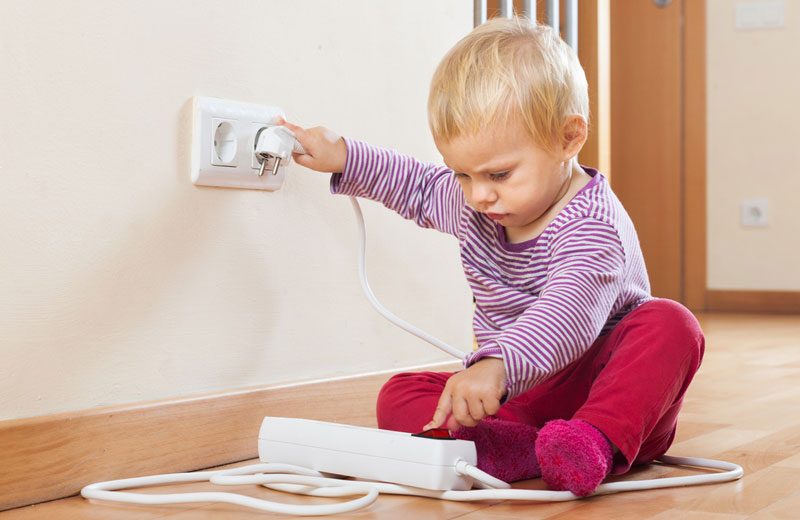
Kids want to know how things work. Electrical outlets, the primary source of power throughout the home, present a conundrum: conveniently placed for easy access, treacherously positioned well within reach of crawling infants and curious toddlers.
Top parenting priority: Protect yourself and family from the many dangers both in and out of the house. Baby proofing electrical outlets cannot be skipped. Most of us know this. Take control of electrical safety for your family and for your home.
Get Serious About Childproofing Electrical Outlets
The Electrical Safety Foundation International (ESFI) reports that approximately 2,400 kids in the USA are treated for injuries caused by electrical outlets each year. In a startling revelation from the ESFI, they also noted that one third of parents with kids have not yet taken steps to childproof electrical outlets throughout their home. So that’s the place to begin.
Baby proofing electrical outlets seems pretty straightforward, but be sure not to skip any of these steps:
1. Reliable Safety Covers on Every Outlet Not in Use
Installing basic plastic outlet covers should really only be considered a quick fix. But definitely begin with this basic step if you take no further action. Children roam and explore, so don’t skip any outlets. Kids will find a way to place fingers, toes and toys into sockets. And know this: research from Biokinetics Research Laboratory at Temple University revealed that 100% of all 2-4-year olds observed in a study were able to remove nearly all types of electrical outlet covers within 10 seconds. Watch those kids closely!
2. Tamper Resistant Receptacles (TRR) - An Upgrade for Plastic Outlet Covers
When you incorporate a tamper resistant electrical receptacle, you actually stop the conducting of an electrical charge for objects other than plug-in cords. This is accomplished with spring-loaded shutters. These shutters are designed only to respond to pronged plugs, and not to spoons, chopsticks and body parts.
3. A Snug Fit for Every Electrical Plug
Consider it dangerous if the fit of your electrical plug and outlet is not a snug one. This typically indicates a replacement of the outlet may be needed, or that there is a defect in the appliance power cord.
4. Install Faceplates on All Outlets.
There are times, especially when painting, that faceplates get removed (though it’s usually a better practice to cover them with tape than to remove). Or maybe a faceplate cracked when a screw got overtightened. It happens. But the moment that faceplate comes off, wires get exposed. Curious hands with tiny objects will find a way in if left ignored. Make sure faceplates are correctly installed on all outlets and reduce the very real risk of electrical shock for all.
5. Don’t Chance It: Call an Electrician When Outlets Stop Working Correctly
There are times when it makes safety sense to call in the pros and make sure you have set yourself up for safety and success. You can often diagnose some of the many issues that come up with electrical outlets. Remember, you’re dealing with power than can injure and destroy. When in doubt, get the experts to come out to test and confirm the safety of an outlet or perform a needed replacement.
6. Make the Update to a Ground-Fault Circuit Interrupter (GFCI) System
A Ground-Fault Circuit Interrupter (GFCI) is a must update to protect your family. GFCI outlets came into existence to help water and electricity play nicely together. They were mainly introduced as a requirement in 1971 when folks started putting underwater lighting into their swimming pools and needed added protection from the obvious danger of electrocution.
Simply put, GFCI’s are designed to protect kids and adults from electric shock and electrocution. By monitoring the level of electricity flow in the circuit and detecting “leaks,” a GFCI can cut power to the outlet. This becomes especially important in those scenarios where a plugged-in hair dryer, curling iron, electric shaver or other appliance falls into a sink or tub filled with water. When this happens, the GFCI can cut power to the outlet to help reduce the risk of injury and fatality.
Bottom line: There is a quick fix and a very basic version of childproofing your electrical outlets. This can’t be skipped. But consider that only a band-aid for needed upgrades, repairs and replacements to fully get your home truly ready for the tiny paper clips, fingers and forks that all too easily find their way into electric sockets. Protect your loved ones by making electrical outlet safety a top priority for today.



























